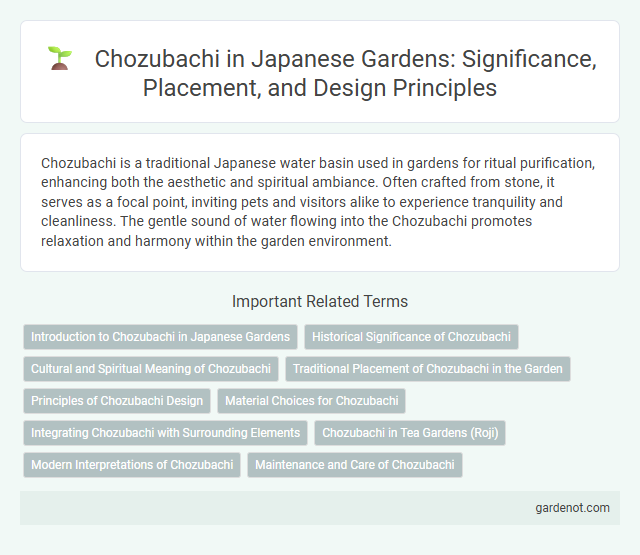Chozubachi is a traditional Japanese water basin used in gardens for ritual purification, enhancing both the aesthetic and spiritual ambiance. Often crafted from stone, it serves as a focal point, inviting pets and visitors alike to experience tranquility and cleanliness. The gentle sound of water flowing into the Chozubachi promotes relaxation and harmony within the garden environment.
Introduction to Chozubachi in Japanese Gardens
Chozubachi is a traditional stone water basin used in Japanese gardens for ritual purification before tea ceremonies or temple visits. Typically crafted from granite or other natural stones, it symbolizes cleanliness and spiritual preparation. Placed near the garden entrance or teahouse, the chozubachi enhances the aesthetic harmony while inviting mindful cleansing.
Historical Significance of Chozubachi
Chozubachi, traditional stone water basins found in Japanese gardens, have historical significance rooted in Shinto purification rituals where visitors cleanse their hands and mouths before entering sacred spaces. These basins symbolize purity and spiritual readiness, reflecting the deep connection between Japanese aesthetics and religious practices. Originating in the Muromachi period, chozubachi have been integral to tea ceremony gardens, emphasizing mindfulness and respect in Japanese culture.
Cultural and Spiritual Meaning of Chozubachi
Chozubachi, a traditional stone basin found in Japanese gardens, holds deep cultural and spiritual significance as it embodies the ritual of purification before entering sacred spaces. Originating from Shinto and Buddhist practices, the water in the Chozubachi symbolizes cleansing of the mind and body, reflecting purity and renewal. This serene element fosters mindfulness and respect, anchoring visitors in a moment of contemplation and harmony with nature.
Traditional Placement of Chozubachi in the Garden
Chozubachi are traditionally placed near garden entrances or along pathways to facilitate ritual hand washing and purification before entering sacred spaces. These stone basins are often positioned beside a bamboo spout, known as kakei, with accompanying ladles (hishaku) arranged for easy access. The placement emphasizes harmony with natural surroundings, ensuring the chozubachi integrates seamlessly into the garden's tranquil aesthetic while serving its functional purpose.
Principles of Chozubachi Design
Chozubachi design emphasizes simplicity, natural materials, and seamless integration with surrounding elements to enhance the tranquil atmosphere of a Japanese garden. The basin's placement follows principles of accessibility and ritual purity, often situated near entrances or pathways to encourage cleansing before entering sacred spaces. Water flow in Chozubachi is carefully controlled to create soothing sounds, symbolizing renewal while maintaining harmony with the garden's overall aesthetic.
Material Choices for Chozubachi
Chozubachi are traditionally crafted from natural materials such as granite, basalt, or ceramic, chosen for their durability and aesthetic harmony with garden elements. Granite offers a rough texture and resilience to weather, making it a popular choice for outdoor installations. Ceramic chozubachi provide smooth surfaces with varied glaze finishes, enhancing visual contrast while maintaining functionality for ritual handwashing.
Integrating Chozubachi with Surrounding Elements
Chozubachi, a traditional Japanese water basin, seamlessly integrates with surrounding elements by being carefully positioned near natural stones, moss, and wooden structures, enhancing the garden's harmonious ambiance. The gentle trickle of water from the bamboo spout into the basin complements the textures of rocks and foliage, creating a sensory experience that embodies wabi-sabi aesthetics. Strategic placement near pathways ensures easy access for ritual handwashing while maintaining visual balance within the garden's overall design.
Chozubachi in Tea Gardens (Roji)
Chozubachi in tea gardens, or roji, functions as a stone water basin used for ritual purification before the tea ceremony, embodying the principles of harmony and respect central to Japanese culture. Crafted from natural stone, these basins are often accompanied by bamboo ladles called hishaku, facilitating the symbolic cleansing of hands and mouth. Positioned strategically along garden paths, chozubachi contribute to the tranquil and contemplative atmosphere essential to the roji experience.
Modern Interpretations of Chozubachi
Modern interpretations of Chozubachi blend traditional Japanese aesthetics with contemporary materials such as stainless steel and glass, enhancing both durability and visual appeal. Designers integrate minimalist forms and innovative water flow mechanisms to create sustainable, user-friendly hand-washing basins within urban garden spaces. These approaches preserve the ritualistic essence of cleansing while adapting to modern architectural contexts and lifestyle needs.
Maintenance and Care of Chozubachi
Proper maintenance of Chozubachi involves regularly cleaning the stone basin to prevent algae buildup and debris accumulation, which ensures clear, fresh water. Seasonal inspection of the bamboo spout and water supply system helps maintain steady water flow and prevents blockages. Using soft brushes and mild detergents preserves the texture and appearance of the stone without causing damage.
Chozubachi Infographic

 gardenot.com
gardenot.com